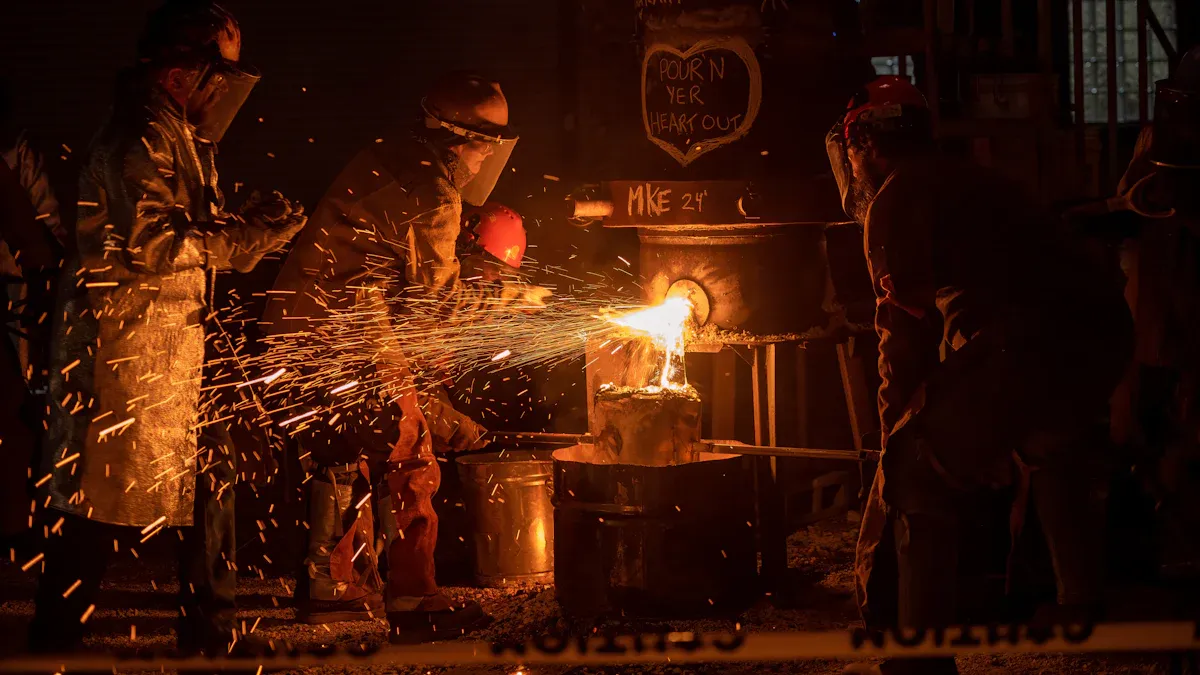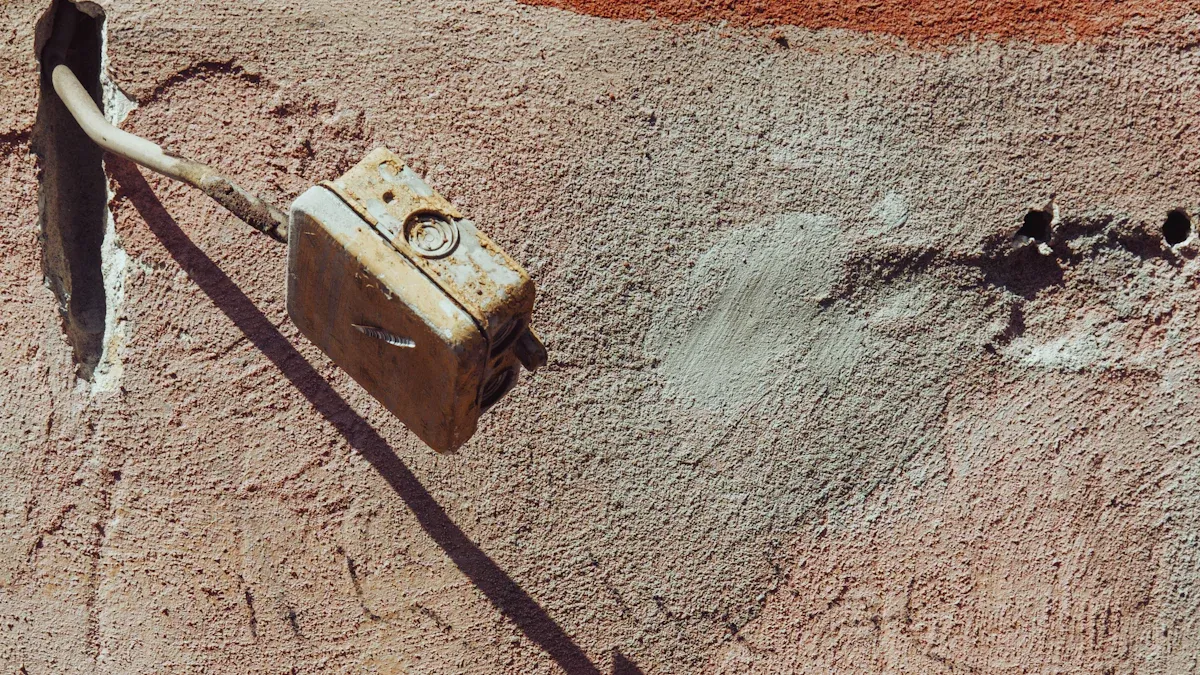You use green sand casting processes to make metal parts fast. This method is very popular, with about 42% of metal castings in the world utilizing green sand moulding. Companies choose this casting process because it saves money and is suitable for many jobs. The main mix consists of silica sand, bentonite clay, water, and additives. Each component plays a crucial role in creating strong and easy-to-shape molds:
Green sand casting processes have supported factories for a long time, and people trust it for a variety of applications.
Key Takeaways
Green sand casting saves money, so it works well for small and medium jobs.
The process uses silica sand, bentonite clay, water, and other things to make strong molds.
Important steps are making the pattern, getting the sand ready, molding, pouring metal, cooling, shaking out, and finishing.
Machine moulding is faster and gives better quality than doing it by hand, so it is good for bigger batches.
The jolt squeeze method makes molds stronger and more exact, so surfaces are smoother.
Green sand casting can be used for many metals and tricky shapes, like thin walls and tiny holes.
Keeping green sand casting machines in good shape is important for steady quality and working well.
Knowing the limits, like how smooth the surface is and how close the sizes are, helps you pick the best casting method for your project.
1. Green Sand Casting Processes

Overview
People use green sand casting processes to make metal parts quickly. This method uses a mold made from wet sand. That is why it is called green sand casting. The sand mix has silica sand, bentonite clay, water, and fillers. Each part helps shape and strengthen the mold. The wet sand lets you make complex shapes without baking the mold. Green sand casting works for many different industries.
Process Steps
The green sand casting process has several important steps. Each step helps make sure the final product is good quality.
Pattern Creation
First, you make a pattern that looks like the part you want. Patterns can be wood, metal, or plastic. The pattern type, like flat back or split, changes how hard or easy the process is.Sand Preparation
Next, you mix silica sand with bentonite clay, water, and fillers. Fillers can be coal powder or dextrin. The sand must have the right amount of water. If it is too wet or dry, the mold can break. For tight molds, keep moisture between 32% and 40%. For high-density molding, use 2.8% to 3.8% moisture. Bentonite makes the mold stronger and stops defects. Coal powder helps make the mold tougher.Moulding
Then, you pack the sand around the pattern in a mold box. You press the sand down to make it firm. After that, you take out the pattern. This leaves a space shaped like your part. If you need holes inside the part, you use sand cores and core prints.Metal Pouring
You heat the metal until it melts. Then, you pour the hot metal into the mold. The metal fills every part of the space made by the sand.Cooling
You let the metal cool down and get hard in the mold. Cooling is important for the right strength and size.Shakeout
You break open the mold and take out the solid metal part. This step separates the finished part from the sand.Finishing
You clean the casting by removing leftover sand and extra material. You might grind, machine, or heat-treat the part to get the right size and smoothness.
Tip: Every step in the process changes how good your final part is. Focus on pattern design, sand mixing, and moisture for the best results.
Equipment
Green sand casting equipment is important for every step. You need good machines and tools to mix, mold, and move materials. Here are the main types of green sand casting equipment and what they do:
Green sand casting equipment helps you keep the sand the same every time. This reduces mistakes and saves time. Machines with controls help stop waste and let you make more or less parts as needed. You should take care of your equipment often. Use strong materials, sealed bearings, and make sure it is easy to clean and fix. Check gears, motors, and mixer blades often to stop problems and keep everything working well.
Note: New green sand casting equipment has better sand control systems. Some machines work with CAD and simulation software. These tools help you plan mold designs and see results before you start making parts.
2. Moulding Variations

Manual Moulding
Manual moulding is good if you want to save money. You do not need fancy machines for this method. You shape the sand by hand around the pattern. This way, you can make small batches or special parts. It is easy to change the mold size. But you might see more mistakes and rougher surfaces. This process takes longer and is less exact.
Manual moulding uses basic tools.
You can make many shapes and sizes.
There may be more casting mistakes.
The surface is rougher than with machines.
Skilled workers are needed for good results.
Here is a quick look at how manual and machine moulding compare:
Machine Moulding
Machine moulding is best when you want fast and steady results. Machines pack the sand tightly around the pattern. This helps you get the same part every time. You can make lots of parts quickly. The surface is smoother and the size is more exact. You need special patterns and machines for this. Machine moulding works well for big batches and regular shapes.
Machine moulding makes more parts faster.
You get smoother surfaces and fewer mistakes.
The process uses advanced green sand casting equipment.
You must use special patterns for the machines.
Machine moulding is best for medium or large parts.
Tip: If you want less work and better parts, machine moulding with new green sand casting equipment is a smart pick.
Jolt Squeeze
The jolt squeeze method helps you make better molds. First, the machine shakes the sand to fill every space. Then, it presses the sand to make it tight and strong. This method uses special green sand casting equipment made for jolt squeeze.
The jolt squeeze method gives you many good things:
You get stronger molds, better size, and smoother surfaces with this method. Jolt squeeze machines help you make good parts faster. You can trust this method for jobs that need tight sizes and nice finishes.
Note: When you use new green sand casting equipment with jolt squeeze, you get great results in both quality and speed.
Technique Impact
When you pick a moulding technique, your castings change. Each method affects how exact, fast, and cheap your work is. You should know how these things change your results.
Key Impacts of Moulding Techniques:
Precision and Detail
Manual moulding lets you make special shapes. But you might see more mistakes and rough spots. Machine moulding gives you better accuracy and smoother parts. Jolt squeeze makes strong molds with tight sizes. Advanced green sand casting equipment helps with tricky designs.Production Speed
Manual moulding is slow because you shape each mold by hand. Machine moulding is faster. Jolt squeeze machines work even quicker. They pack sand tight and save time. Automated green sand casting equipment helps you make more parts fast.Cost-Effectiveness
Manual moulding costs less for small jobs. Machine moulding and jolt squeeze cost more at first. But you save money when you make lots of parts. Green sand casting equipment lets you use sand again and control waste. This lowers your costs.Suitability for Complex Parts
Machine moulding and jolt squeeze work better for hard shapes than manual methods. You get fine details and steady results. Permanent mold casting does not work well for tricky parts. You lose detail when filling. Green sand casting equipment helps you make many complex parts.Dimensional Accuracy
Jolt squeeze and machine moulding give better size control. Manual moulding is not as exact. Permanent mold casting is good for simple shapes. But it costs more and takes longer.
Tip: You get better casting quality and speed with new green sand casting equipment. Automated systems help keep molds the same and stop mistakes.
Comparison Table: Impact of Moulding Techniques
You get the most accuracy and speed with machine moulding and jolt squeeze. Green sand casting equipment helps you finish jobs fast and make good parts. Pick your technique based on job size, part shape, and budget.
Note: Green sand casting equipment is flexible. You can switch between manual, machine, and jolt squeeze methods. This helps you stay ahead in the casting business.
3. Advantages
Cost-Effectiveness
Green sand casting helps you save money. This method is good for small and medium jobs. You do not spend much on tools or setup. Sand molds cost less, between $6,000 and $20,000. You can use the sand again, so you buy less material. Green sand casting equipment helps you waste less and work faster.
You spend less on tools than other casting methods.
Sand casting is quick and cheap for small batches.
Die casting costs less for big jobs but needs more money first.
Sand molds are cheap, so green sand casting is good for samples and small jobs.
Green sand casting equipment lets you reuse sand and save resources.
Tip: If you want to spend less and avoid big costs, green sand casting is a smart way to go.
Design Flexibility
Green sand casting lets you make many shapes. You can create parts with thin walls and tricky designs. This process helps you make engine blocks and other detailed parts. You can make walls as thin as 0.09 inches. Small holes, from 0.19 to 0.25 inches, are possible. Green sand casting equipment packs sand tight and helps with hard patterns.
You can make thin walls that other methods cannot.
Tricky shapes, like engine blocks, are easy to cast.
Small holes and openings add more choices.
Green sand casting equipment helps you make detailed parts.
Note: Green sand casting gives you more design choices than most other casting methods.
Material Range
Green sand casting works for many metals and alloys. You can use it for aluminum and zinc. Green sand casting equipment can handle different metals, so you do not need to change much. Here are some metals you can cast:
Green sand casting equipment lets you use many materials. You can meet different project needs and follow industry rules.
Tip: If you want to cast different metals, green sand casting is flexible and works well.
Production Rate
Green sand casting equipment lets you make lots of molds fast. You can create many molds in just a short time. If you use automated systems, you can make over 300 molds every hour. This fast speed is why green sand casting is so popular for both ferrous and nonferrous metals.
Green sand casting equipment helps you make big batches.
Automated machines keep your work steady and dependable.
You can change the equipment for different shapes and sizes.
Green sand casting gives you more choices than die casting. Die casting is quicker for each cycle, but it does not work for every metal or design. With green sand casting equipment, you can switch jobs easily. You can do mass production or special orders without changing your setup.
Tip: If you want to make more parts and save money, get new green sand casting equipment. You will have fewer slowdowns and better results.
Applications
You can use green sand casting equipment in many fields. This process works for simple and hard parts. Green sand castings are used in cars, buildings, and big machines.
Used for cars and heavy trucks
Used for airplane parts
Used for energy and power plants
Used for building machines
Used for many factory jobs
Green sand casting equipment helps you make engine blocks and brake drums. You can also make gear housings, pump parts, and turbine pieces. The process works for both big and small projects. With the right equipment, you can meet tough industry rules.
Note: When you pick green sand casting equipment, you can work in many markets. You can help car, airplane, and building companies with strong castings.
4. Limitations
Surface Finish
When you use green sand casting equipment, the surface is rougher than with other methods. The sand and water in the mold leave marks on the metal part. The surface finish can be between 250 and 1,000 micro inches (RMS). How smooth the part is depends on the sand, the way you mold, the pattern, the metal, and how hot you pour it. If you want a smoother part, you need better sand or more work after casting, which costs more.
Green sand casting equipment makes rougher surfaces than chemically bonded processes.
Asking for very smooth surfaces will make the cost go up.
Shell sand and vacuum casting give smoother finishes. Shell sand is 75-150 RMS, and vacuum casting is 150-200 RMS.
Designers pick green sand casting when the surface finish is not very important.
Tip: If you want a smoother part, you can grind or polish it after casting. Green sand casting equipment is best for parts where looks do not matter much.
Tolerances
Green sand casting equipment gives you wider tolerances than other casting methods. The sand mold can move or change shape when you pour and cool the metal. This means your part might not be the exact size you want. The size difference can be from ±0.5% to ±2.0%. If you need a more exact size, you may need to machine the part or use another process.
Here is a table that compares tolerances for different casting methods:
Green sand casting equipment lets you make many shapes, but you lose some accuracy. If your part must be very exact, plan for extra machining or use a process with tighter tolerances.
Note: Always check what tolerance you need before picking green sand casting equipment. This helps you avoid mistakes that cost money.
Size Limits
Green sand casting equipment lets you make parts in many sizes. You can cast small parts that weigh just a few ounces. You can also make big parts up to 7,000 pounds. The wall can be as thin as 0.09 inches, and there is no set maximum for thickness. This makes green sand casting equipment good for both small and large jobs.
You can use green sand casting equipment for engine blocks, machine frames, and other big parts. For very thin walls or huge castings, you might need special equipment or a different method. The mold size depends on your green sand casting equipment and the space in your foundry.
You can make both small and big parts.
Thin walls are possible, but very thin parts need extra care.
There is no strict maximum for wall thickness, but thick parts may cool unevenly.
Tip: Always check what your green sand casting equipment can handle before starting a new job. This helps you avoid problems with mold size and part quality.
Defects
When you use green sand casting equipment, you might see different defects in your castings. These problems can change how strong, good-looking, or useful your parts are. It is important to know the most common defects and ways to stop them. The table below shows main defects, what they look like, and why they happen:
You can lower these defects by using green sand casting equipment the right way. Here are some tips to help you make better castings:
Use good risers and chills to control shrinkage.
Keep the moisture in your green sand just right.
Make gating systems smooth so metal flows well.
Pick finer sand and pour at the right temperature to stop metal penetration.
Other defects can happen too, like gas problems, shrinkage holes, and metal issues. These usually come from bad venting, sand that does not let air through, or cooling mistakes. Green sand casting equipment helps you control sand mixing, moisture, and temperature. This can stop many common problems.
Here is another table with more defects and why they happen:
To stop these defects, you should:
Keep green sand moisture between 2% and 4%.
Make sure sand grains are the right size and mixed well.
Add enough vents to the mold.
Design gating to keep metal flow smooth.
Pour metal at the right temperature so less gas gets in.
Tip: Check and take care of your green sand casting equipment often. This helps you find problems early. You can fix your process and make better castings.
Green sand casting equipment lets you control many things. If you use the best settings and follow good steps, you can lower defects and make strong, good parts.
5. Comparison with Other Casting Processes
Dry Sand Casting
Dry sand casting is different from green sand casting. You mix sand with clay or special binders. Then, you shape the sand into a mold. Next, you bake the mold in an oven. Baking makes the mold strong and steady. When you pour hot metal, the mold keeps its shape. This helps you get parts with fine details and good accuracy.
Dry sand casting gives better size control.
You can make detailed shapes and smoother surfaces.
Green sand casting costs less and is faster.
You need extra finishing with green sand casting for tight sizes.
Dry sand casting is good for high-quality parts. People use it for engine blocks, pump housings, gearboxes, turbine cases, and machine frames. Green sand casting equipment helps you make lots of parts quickly. Dry sand casting is better for jobs that need more detail.
Note: Dry sand casting is best for strong molds and fine details. Green sand casting equipment is better for fast jobs and saving money.
Shell Moulding
Shell moulding makes parts with smooth surfaces. You use a heated pattern and cover it with sand mixed with resin. The resin gets hard and forms a shell. This shell is the mold for casting.
Here is a simple comparison:
Shell moulding helps you make tricky shapes with fewer problems. You get strong molds and better control over wall thickness. The process costs more because you need resin and special tools. Green sand casting equipment costs less and works for many shapes. But you may see more mistakes and rough surfaces.
Tip: Use shell moulding for smooth parts and tight control. Pick green sand casting equipment for cheaper and flexible jobs.
Investment Casting
Investment casting gives the best accuracy and smoothness. You make a wax shape and cover it with ceramic. Then, you melt out the wax. The ceramic shell becomes the mold. You pour metal into the shell to make the part.
Investment casting is best for small, tricky parts that need tight sizes. You pay more for materials and steps. Green sand casting equipment helps you save money on bigger, simple parts. But you may need extra work to get the right size.
Note: Choose investment casting for detailed, accurate parts. Use green sand casting equipment for bigger parts and lower costs.
Die Casting
Die casting is a quick and accurate way to make metal parts. You push melted metal into a steel mold using high pressure. This works best for metals like aluminum, zinc, and brass. The parts come out smooth and fit together very well. Die casting is good for making lots of the same part. You get the same results every time.
When you look at die casting and green sand casting equipment, you see they are different. Die casting is much faster. You can make thousands of parts in a short time. Green sand casting equipment takes longer because you must make each mold. Sand casting lets you make bigger or odd-shaped parts more easily.
Here is a table that shows how they are different:
Pick die casting if you need lots of small, detailed, and smooth parts. Green sand casting equipment is better for big parts or if you want to use iron or steel. Die casting costs more at first because you need special molds and machines. Green sand casting equipment costs less and you can use the sand again.
Tip: Use die casting for big jobs with non-ferrous metals. Choose green sand casting equipment if you want more choices and lower costs.
Selection Guide
When you pick a casting process, you need to think about a few things. Green sand casting equipment has many good points, but you must match it to your project.
Casting Size and Complexity: Big and tricky parts need strong sand. Small parts use green sand to save money.
Desired Surface Finish: Finer sand makes smoother parts. Green sand casting equipment gives rougher parts that may need more work.
Thermal Properties: Hot metals need sand that can handle heat. Green sand casting equipment works for many metals, but check what you need.
Permeability: Green sand lets gases out. This helps stop problems and makes better parts.
Availability and Cost: Think about how easy it is to get sand and how much it costs. Green sand casting equipment saves money and uses common sand.
Note: Always check your part size, metal, and finish before picking green sand casting equipment. This helps you get good results and saves money.
You can use green sand casting equipment for many kinds of jobs. It is flexible, saves money, and works with lots of metals. If you want smoother parts or tighter fits, try other ways. For most jobs, green sand casting equipment is a good and steady choice.
You now know that green sand casting equipment helps make casting fast and flexible. This method saves money, lets you make many designs, and works quickly. Think about these things before you start a new project: Material costs are low because sand and clay are cheap. You can make molds fast and use the sand again, so work goes faster. Picking the right supplier is important for good quality and steady results. Using green sand casting helps you waste less and is better for the environment.
FAQ
What is green sand casting equipment?
Green sand casting equipment has machines and tools for mixing and shaping wet sand. You use these tools to make strong molds fast. This helps you cast metal parts easily.
How often should you maintain green sand casting equipment?
Check and clean your green sand casting equipment once a week. Doing this often stops problems and keeps your work going well.
Can you reuse sand in green sand casting equipment?
Yes, you can use the same sand many times. This saves money and makes less waste in your foundry.
What metals work best with green sand casting equipment?
You can cast aluminum, iron, steel, and zinc with this equipment. It lets you work with many metals for different jobs.
Does green sand casting equipment improve casting quality?
This equipment helps you mix sand and control moisture better. You get stronger molds and fewer mistakes in your castings.
How do you choose the right green sand casting equipment?
Think about your part size, how many you need, and what metal you use. Pick equipment that fits your job and your workspace.
What safety steps should you follow with green sand casting equipment?
Wear gloves, goggles, and special clothes to stay safe. Keep your area clean and follow all safety rules for the equipment.
Is green sand casting equipment suitable for large-scale production?
Automated green sand casting equipment is good for big jobs. These machines can make hundreds of molds each hour and keep the quality steady.

